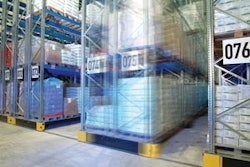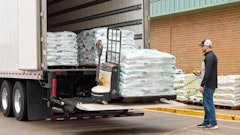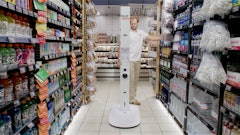Warehouse management systems to-day have gone far beyond the four warehouse walls, and the hardware needed to run them continues to be faster, cheaper and more nimble. Unfortunately, the grocery industry—retailers, wholesalers and distributors alike—have not kept pace.
Many in the industry are still using 20- and 30-year-old home-grown and legacy systems to run their warehouses, and, as a result, are losing out on the functionality that more modern systems offer, according to many experts.
The use of home-grown warehouse management systems is more prolific in the grocery industry than one might think. "My gut tells me that half [of the industry] is still using home-grown systems," says Marc Wulfraat, a senior partner at KOM International, a global logistics and supply chain consulting firm based in Montreal. "I'm amazed at how many antiquated, highly customized applications are still out there. In grocery, it's not uncommon to have a system for 20 years.
"They've done nothing for 25 years, and are now wondering why the world is passing them by," he observes.
That's because many of these old systems were never designed to handle the hardware or software needed to run modern applications like scanning, voice, inventory tracking, radio frequency identification and the like. In fact, many of those technologies did not even exist when many systems were installed in the late 1970s and early 1980s.
Nor do these older systems provide the real-time access to data that is required by law today. The federal government, under provisions contained within the Bioterrorism Act, is now requiring that companies involved in the production, distribution and sale of food to keep strict records for up to two years regarding the source and destination of all shipments.
Those records must include vendor and supplier contact information, date received and released, route of movement and transfer points during shipment and specific information about the type and quantity of all food handled. They will have to be able to produce those records within 24 hours of a request or they could face severe civil or criminal penalties.
"Because of this, even the smaller companies are going with some form of WMS. Manually doing this on paper is very difficult and time-consuming," says Kurien Jacob, CEO of Advanced Foodsystems, Phoenix. "Up until last year, there were a lot of legacy systems out there. Now, most companies are being forced to get rid of them."
Bioterrorism has been among the biggest drivers toward new WMS implementations, admits George Marin, product solutions manager at Retalix USA, the Israeli firm with U.S. headquarters in Dallas. "The move is to buy solutions that give greater controls over tracking and tracing," he says. "Older databases have limited capacity and there are a lot of timing issues. A lot of the older systems are still using end-of-the-day batch updates, and it takes a large amount of time to enter the data and put it into the system."
"We're getting a lot of activity in terms of replacements of old systems," says Howard Hargrove, a major account executive with Manhattan Associates in Atlanta. "Many need new systems for the bioterrorism regulations and tracking and tracing. They're not replacing their old WMS systems just because they're old, but because they have to."
Problems With Interactivity
Among the other problems with existing legacy systems are an inability to interact with other supply chain and financial applications that are now becoming a standard in food distribution.
"With the old-model WMS, the whole purpose was to optimize activities within the four walls of the warehouse, and they did a good job of it," says Hargrove. "The new WMS has to look at what's beyond the four walls.
"The prospects that we're talking to are trying to maximize their capital to compete with the likes of Wal-Mart. The new distribution model looks at the whole supply chain to maximize every piece. The WMS has to be aware of inventory in transit, in the yard and on order, to know what's coming in and what's in inventory now.
"Grocers are looking to synchronize the inbound and outbound so that the DC becomes a flow-through facility. They're finding that their old batch systems are a plug in the pipeline because they can't do this real-time inventory matching," he continues.
"These batch systems are unacceptable in the new demand-driven supply chain. The key has to be an ability to interact with the fleet, the yard, the transportation management system, etc."
Unlike older systems, the more modern WMS solutions "extend visibility upstream so customers can anticipate demand, allowing them to adapt to changing customer needs and generate a higher return on their inventory investment," says Jeff Mitchell, executive vice president of Manhattan Associates. "When you're dealing with perishable items, effective inventory management and accurate forecasting are essential."
It also has to look at the world in general, as many companies adopt a more global supply chain that includes sourcing from abroad and outsourced manufacturing, which often requires raw materials to be shipped from a supplier in one country to a plant in another, the semi-finished products to be sent somewhere else for finishing, and the finished product to be sent to warehouses and retailers all across the world.
"In food, globalization is big right now. We're also seeing a bigger presence by [third-party logistics providers], and a greater amount of [direct store delivery]. Then there's voice, which has really taken off, allowing companies to work faster and increase accuracy in order picking. You need solutions with that kind of reach," adds Eric Nilsson, senior director of solutions management at SSA Global, Chicago.
Other supply chain applications in the food industry include labor management, yard management, fleet and transportation management, demand planning, forecasting, scheduling, temperature logging and a lot more. Many older systems simply do not support those types of applications.
"They use databases that have limited capacity," says Marin of Retalix. "There are also less redundancies when you have more modern systems.
"They also do not incorporate voice, radio frequency, etc., and if they do, they have to be heavily modified. You have to look at each of those different applications and customize around them, and that adds to the cost and time to implement," he adds.
Systems also need to be able to support hundreds of users at the same time, and many of the older systems couldn't do that. "This kind of throughput was previously limited to more expensive AS400 and Unix-based systems running custom or vendor-configured code," says Ann Price, president and CEO of Motek, Beverly Hills, CA. Warehouse managers "are tired of being unable to support or upgrade complicated, customized software."
Keeping It Food-Specific
According to KOM's Wulfraat, until now, many food companies have continued to use their old, outdated WMS solutions because they did not have the money to invest in replacements or upgrades. "This is a very conservative industry with tight margins that is not spending a lot of money," he says. "Often, there's not a lot of money to invest."
Companies are also sticking to their old systems because of the amount of customization that went into them during the initial implementation. "When you've gone through the heartache of choosing and implementing a solution and getting it to work with all your other systems, you don't want to touch it," Wulfraat says. "The tendency is to put it in and leave it there for 20 years."
Then there is an underlying fear that no solution can do all that is needed. "When you talk about grocery, you have very different requirements," he explains.
"You can't take a generic distribution package and make it work in the food industry without major modifications," adds Marin.
"Food is very much a niche business with a lot of idiosyncrasies that you do not find anywhere else. You need solutions geared to the food industry because of those unique idiosyncrasies."
Among them, according to Marin, are expiration dates, weighted items with random catch weights, seasonality, temperatures, rebates and bill backs, backhauls and the need for tracking and tracing.
The lack of investment has got to change. "A lot of wallets are going to have to be opened up now," Wulfraat says.
And, after a number of lean years, the WMS providers would love to see nothing more. The past five years have really been a roller coaster ride for many firms, dating back to 2000 when issues with Y2K compatability first emerged.
All indications are that they are starting to see an uptick in business opportunities. In a recent EyeForTransport survey, 37 percent of respondents said that they planned to deploy a WMS this year. Among them, 91 percent said that inventory management and a lack of supply chain visibility were their greatest supply chain challenge, and 84 percent said that optimizing their warehouse management was a big key to overcoming their supply chain issues.
The bottom line, according to Nilsson, is that "most systems were written a long time ago and companies are starting to take notice of what they will be able to do looking forward and finding that it is limited."
















